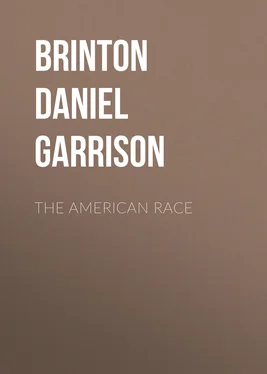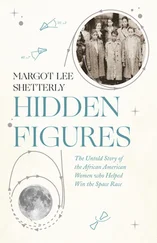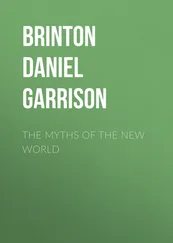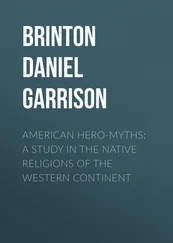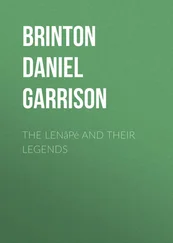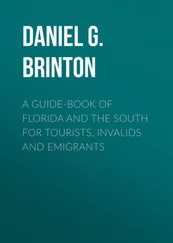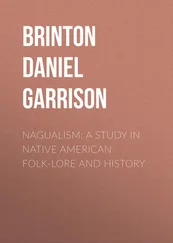Daniel Brinton - The American Race
Здесь есть возможность читать онлайн «Daniel Brinton - The American Race» — ознакомительный отрывок электронной книги совершенно бесплатно, а после прочтения отрывка купить полную версию. В некоторых случаях можно слушать аудио, скачать через торрент в формате fb2 и присутствует краткое содержание. Жанр: foreign_antique, История, История, foreign_edu, на английском языке. Описание произведения, (предисловие) а так же отзывы посетителей доступны на портале библиотеки ЛибКат.
- Название:The American Race
- Автор:
- Жанр:
- Год:неизвестен
- ISBN:нет данных
- Рейтинг книги:4 / 5. Голосов: 1
-
Избранное:Добавить в избранное
- Отзывы:
-
Ваша оценка:
- 80
- 1
- 2
- 3
- 4
- 5
The American Race: краткое содержание, описание и аннотация
Предлагаем к чтению аннотацию, описание, краткое содержание или предисловие (зависит от того, что написал сам автор книги «The American Race»). Если вы не нашли необходимую информацию о книге — напишите в комментариях, мы постараемся отыскать её.
The American Race — читать онлайн ознакомительный отрывок
Ниже представлен текст книги, разбитый по страницам. Система сохранения места последней прочитанной страницы, позволяет с удобством читать онлайн бесплатно книгу «The American Race», без необходимости каждый раз заново искать на чём Вы остановились. Поставьте закладку, и сможете в любой момент перейти на страницу, на которой закончили чтение.
Интервал:
Закладка:
In spite of the hardships of their life, the Innuits are of a singularly placid and cheerful temperament, good-natured among themselves and much given to mirth and laughter. 67 67 “Unlike the Indian,” writes Mr. F. F. Payne, “the Eskimo is nearly always laughing, and even in times of great distress it is not hard to make them smile.” “The Eskimo at Hudson Strait,” in Proc. Canad. Institute , 1889, p. 128.
The ingenuity with which they have learned to overcome the difficulties of their situation is quite surprising. In a country without wood or water, frightfully cold, and yielding no manner of edible fruit or vegetable, they manage to live and thrive. Their principal nurriture is the product of the sea. They build boats called kayaks or bidarkas from the bones of walrus covered with the skins of seals; their winter houses are of blocks of snow laid up on the principle of the circular arch to form a dome, with windows of sheets of ice. These they warm by means of stone lamps fed with blubber oil. Their clothing is of bird skins and furs, and they are skilled in the preparation of a sort of leather. As faithful companions they have their dogs, intelligent animals, used both in hunting and for drawing small sledges built of wood or bone.
With their tools of bone or stone they fashion many curious and useful articles, displaying a marked inventive faculty and an artistic eye. The picture-writing which they devised for the assistance of their memory is greatly superior to any found north of Mexico in the faithful delineation of objects, especially of animal forms. 68 68 W. J. Hoffman, “On Indian and Eskimo Pictography,” in Trans. Anthrop. Soc. of Washington , Vol. II, p. 146.
The long winter nights are enlivened by music and songs, of which they are passionately fond, and by the recital of imaginative tales, the stock of which is inexhaustible. A skillful bard enjoys a wide reputation, and some of their poems contain fine and delicate sentiments. 69 69 See some examples in my Essays of an Americanist , pp. 288-290 (Philadelphia, 1890).
Others are from ancient date, and are passed down from generation to generation with scrupulous fidelity, every tone, every gesture, being imitated. The meter and rendition of their songs seem to the European monotonous, but the Eskimo has his own notion of the music of verse, and it is a very advanced one; he would have it akin to the sweet sounds of nature, and for that reason their poets sleep by the sound of running water that they may catch its mysterious notes, and model on them their own productions. 70 70 G. Holm, Les Grönlandais Orientaux , p. 382 (Copenhagen, 1889).
These songs also serve as a peaceful means to allay feuds. When two persons quarrel, they will appoint an evening and sing “nith songs” at each other, and the audience will decide which comes out best. This verdict will put an end to the ill-feeling.
The imaginative character of the people is also reflected in their religions. They believe in one or several overruling powers, and in a multitude of inferior spirits and uncanny monsters. These require propitiation rather than worship. The general belief is that a person has two souls, one of which is inseparably connected with his name and passes with it to any infant named for him; while the second either descends to a warm and pleasant abode under the earth or passes to a less agreeable one in the sky; the streaming lights of the aurora borealis were sometimes thought to be these latter spirits in their celestial home.
The rites of their religion were performed chiefly by the priests, called angekoks , who, however, were little better than conjurers. In some parts this office was hereditary.
The language of the Innuits is very much the same throughout the whole of their extended domain. Bishop de Schweinitz once told me that a few years ago a convert from the Moravian mission in Labrador went to Alaska, and it required but a few weeks for him to understand and be understood by the natives there. In character the tongue is highly agglutinative, the affixes being joined to the end of the word. The verb is very complex, having thirty-one hundred modified forms, all different and all invariable. 71 71 Dr. A. Pfizmaier, Darlegungen Grönländischer Verbalformen (Wien, 1885).
It is rich in expressions for all the objects of Eskimo life, and is harmonious to the ear. Like the Greek, it has three numbers, singular, dual and plural.
Those Eskimos who live in Asia call themselves Yuit , a dialect form of Innuit. They dwell around East Cape and the shore south of it, in immediate contact with the Namollos or Sedentary Chukchis, a Sibiric people, totally different in language, appearance and culture. The Yuits have not at all assimilated to the reindeer-keeping, pastoral habits of the Chukchis, and by their own well-preserved traditions, moved across the straits from the American side, with which they continue commercial intercourse. Their villages are sometimes close to those of the Namollos, or Sedentary Chukchis, they intermarry, and have a jargon sufficient for their mutual purposes; but it is an error, though a prevailing one, to suppose that they are the same people. The Chukchis never entered America, and the Innuits, as a people, never crossed from Asia, or originated there. 72 72 On the relative position of the Chukchis, Namollos and Yuit, consult Dall in American Naturalist , 1881, p. 862; J. W. Kelly, in Circular of the U. S. Bureau of Education , No. 2, 1890, p. 8; A. Pfizmaier, Die Sprachen der Aleuten , p. 1 (Vienna, 1884). The Yuits are also known as Tuski . The proper location of the Namollos is on the Arctic Sea, from East Cape to Cape Shelagskoi (Dall).
The jade implements of northeastern Siberia have proved to be of the Alaskan variety of that stone, and not the Chinese jade, as some supposed. 73 73 Proceedings of the U. S. National Museum , 1883, p. 427. All of Clement G. Markham’s arguments for the Asiatic origin of the Eskimos have been refuted.
From all points whence we have definite information, this interesting people are steadily diminishing in numbers, even where they are not in contact with the whites. The immediate causes appear to be increasing sterility and infant mortality. Two surviving children to a marriage is about the average productiveness, and statistics show that it requires double this number for a population to maintain itself even stationary.
The Aleutian branch occupies the long chain of islands which stretch westward from the southwestern corner of Alaska. The climate is mild, the sea abounds in fish, and innumerable birds nest in the rocks. We may therefore believe the navigators of the last century, who placed the population of the islands at 25,000 or 30,000 souls, although at present they have sunk to about 2,000. They have the same cheerful temperament as the Eskimos, and their grade of culture was, when first discovered, about the same. In their own language they call themselves Unangan , people, the name Aleutes having been given them by the Russians. 74 74 Either from the river Olutora and some islands near its mouth (Petroff); or from Eleutes, a tribe in Siberia, whom the Russians thought they resembled (Pinart).
It may be considered settled that their ancestors populated the islands from the American and not the Asiatic side. Not only do their own traditions assert this, 75 75 Ivan Petroff, in Trans. Amer. Anthrop. Soc. , Vol. II, p. 90.
but it is confirmed by the oldest relics of their culture, which is Eskimo in character, and by their language, which is generally acknowledged to be a derivative of the Alaskan Eskimo. 76 76 Comp. H. Winkler, Ural-Altäische Völker und Sprachen , s. 119, and Dall, Contributions to N. Amer. Ethnology , Vol. I, p. 49, who states that their tongue is distinctly connected with the Innuit of Alaska.
It is divided into two dialects, the Unalashkan and Atkan, not very dissimilar, and is remarkable for the richness of its verbal forms. 77 77 Dr. A. Pfizmaier, Die Sprache der Aleuten und Fuchsinseln , s. 4 (Vienna, 1884).
Интервал:
Закладка:
Похожие книги на «The American Race»
Представляем Вашему вниманию похожие книги на «The American Race» списком для выбора. Мы отобрали схожую по названию и смыслу литературу в надежде предоставить читателям больше вариантов отыскать новые, интересные, ещё непрочитанные произведения.
Обсуждение, отзывы о книге «The American Race» и просто собственные мнения читателей. Оставьте ваши комментарии, напишите, что Вы думаете о произведении, его смысле или главных героях. Укажите что конкретно понравилось, а что нет, и почему Вы так считаете.
